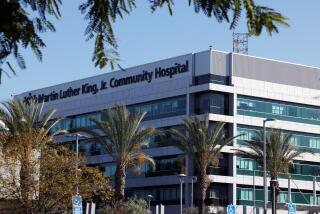Cost of King/Drew Overhaul Is Soaring
- Share via
The effort to fix Martin Luther King Jr./Drew Medical Center is expected to cost Los Angeles County taxpayers $47 million this fiscal year alone -- far more than has been publicly discussed.
The costs come on top of the hospital’s regular budget -- already more per patient than the county’s other three public general hospitals. Although the number of inpatients the hospital cares for each day has dropped sharply, King/Drew’s spending has not decreased, county officials said.
Instead, the county is spending at an average rate of roughly $900,000 per week to supplement King/Drew’s doctors and nurses with visiting staff.
About 325 of the hospital’s 524 nursing positions are vacant. Many nurses have simply left the hospital. Others have been suspended or fired, called in sick or simply haven’t shown up for work. As a result, hospital managers have been forced to hire expensive temporary nurses to fill in.
Millions more are going to pay for medical work once done by physicians in training. Three physician training programs at the hospital have been ordered closed because of deficiencies.
“It’s the cost of having a crisis and it’s the cost of taking aggressive action,” said Dr. Thomas Garthwaite, director of the county health department.
“Whether we can sustain it is another question,” said Supervisor Zev Yaroslavsky. “Money is money, but lives are irreplaceable....[But] if we’re spending all this money and we haven’t turned a corner, it’s a colossal waste.”
Since last fall, the most visible price tag for overhauling King/Drew has been the $13.2 million the county is paying Navigant Consulting Inc. to run the 33-year-old hospital just south of Watts.
But officials with the Department of Health Services estimate that fixing King/Drew will cost the county nearly four times that amount by June 30, the end of this fiscal year.
And even that tally does not reflect the full impact that King/Drew’s troubles are having on county finances.
Because King/Drew is now seeing fewer patients, the county will receive some $20 million less in revenue from the hospital. And plans to reduce the hospital’s regular budget by $18.5 million to bring it more in line with other county hospitals have been postponed for fear of disrupting reforms.
The county also will pay nearby private hospitals at least $500,000 more than budgeted this fiscal year to care for the uninsured patients it was unable to admit because of problems at the hospital.
The costs of fixing King/Drew began before this year and probably will continue long after, officials said. In the fiscal year that ended last July, the county paid out nearly $10 million and lost $8.8 million in revenue, county statistics show.
Supervisor Mike Antonovich said Friday that he was surprised the tab for King/Drew’s troubles had risen so high and that the spending must stop.
“Dumping good money into a sinkhole does not fix the problem,” he said.
The millions spent keeping King/Drew afloat, he said, were “compounding the fiscal meltdown” in the health department, which faces huge deficits in the coming years.
“We’ve reached that point where I don’t support giving them any more,” Antonovich said, recommending that the hospital immediately sever its relationship with the affiliated medical school that runs its doctor training programs and downgrade to a smaller community hospital.
But other county officials said this week that they have no choice but to pay what it takes to fix King/Drew. The hospital serves mostly poor Latino and black neighborhoods with few other options for care. And its status as a hard-won gain from the Watts riots has given it a symbolic role among many in the community.
“It’s the price you have to pay for trying to rebuild a hospital while you keep it open,” Yaroslavsky said.
“The worst situation is spending all this additional money and not making the necessary reforms and then having to make more draconian reforms. That would be a travesty.”
Yaroslavsky and other county officials say King/Drew’s ongoing problems -- and the media’s coverage of them -- have made recruiting quality permanent staff difficult.
A five-part series in The Times in December documented how errors and neglect by King/Drew’s staff have repeatedly injured or killed patients over more than a decade, a pattern that had remained largely unexamined.
The series also found that the hospital’s failings did not stem from a lack of money, as its supporters had long contended. Millions of dollars have gone to such things as unusual workers’ compensation claims and high doctors’ salaries.
King/Drew has the highest percentage of nursing vacancies among county hospitals, which means it must continue to rely on expensive temporary nurses. It also has agreed to pay the nurses it does hire a 10% premium above what nurses earn at other county-run hospitals.
Health department officials said that about $6 million of the current costs for temporary nurses could be due to the hospital’s difficulty in meeting stricter state nurse-to-patients ratios.
Navigant already has requested more money to do its job this year -- including hiring six nurse managers at $36,000 per month. After county officials balked, Navigant agreed to cut its request. The firm also has said it will need another year to complete the job, but it hasn’t asked for funding yet.
So far, county officials say, the county’s other public hospitals have not been harmed by the millions being pumped into King/Drew.
But no one seems to know how long the county can continue to foot the bill, at least at the same level.
“I don’t think we can sustain the King/Drew situation forever,” Yaroslavsky said. “There’s going to be a fish-or-cut-bait point. All of the issues -- financial, incompetence, corruption -- are all going to contribute to when that point is.”
More to Read
Sign up for Essential California
The most important California stories and recommendations in your inbox every morning.
You may occasionally receive promotional content from the Los Angeles Times.










